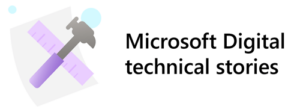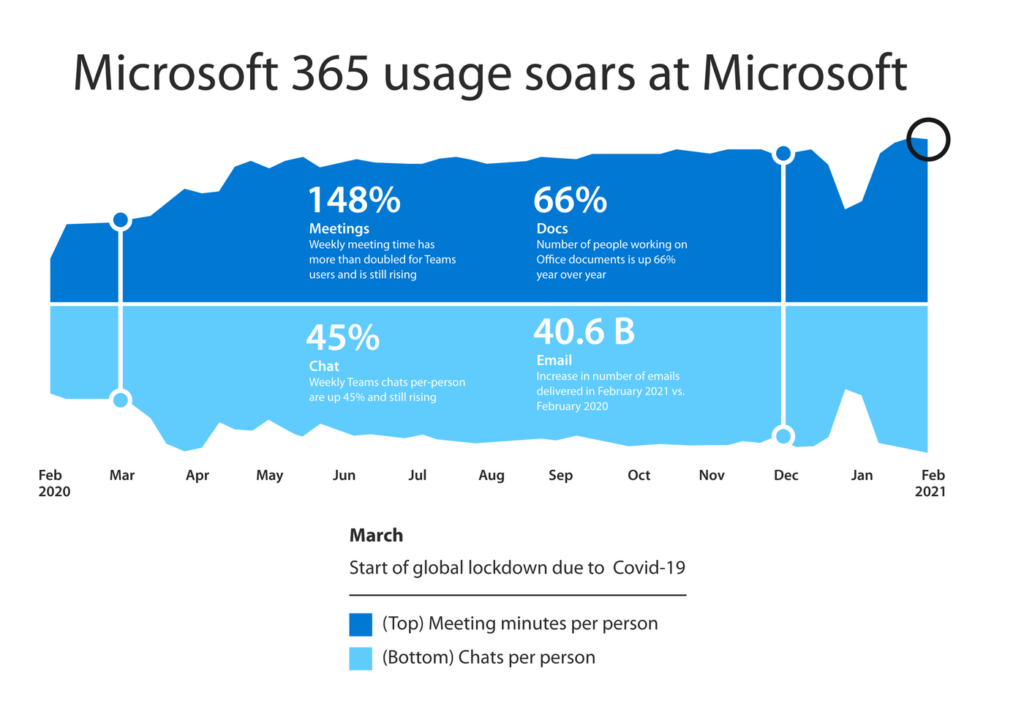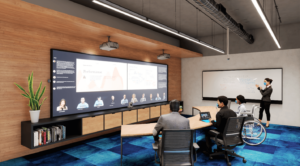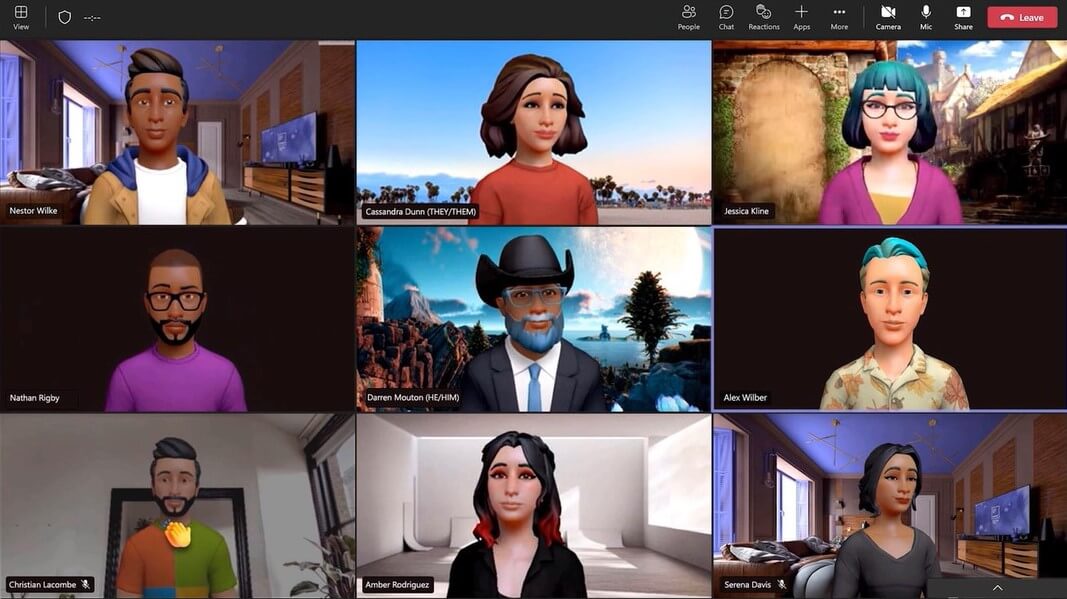 On March 13, 2017, Microsoft announced the general availability of one of our most important products ever. It wasn’t an update to the Windows operating system or a new Microsoft Azure service. It was the launch of Microsoft Teams, an integrated collaboration platform that brought together secure chat, real time communication, and integrated collaboration services for all Microsoft Office 365 users. Overnight, Microsoft Teams became the hub for teamwork for millions of people globally, profoundly changing the way they collaborate and communicate every day.
On March 13, 2017, Microsoft announced the general availability of one of our most important products ever. It wasn’t an update to the Windows operating system or a new Microsoft Azure service. It was the launch of Microsoft Teams, an integrated collaboration platform that brought together secure chat, real time communication, and integrated collaboration services for all Microsoft Office 365 users. Overnight, Microsoft Teams became the hub for teamwork for millions of people globally, profoundly changing the way they collaborate and communicate every day.
There are very few applications or services that have had the transformative impact that Teams has had at Microsoft. Every day, over 200,000 employees all over the world wake up, turn on their PCs, and start to collaborate with Teams. It’s hard to remember what Microsoft was like before Teams, but I know I wouldn’t want to go back!
—Eileen Zhou, principal product manager, Microsoft Digital
Microsoft Digital was there from the beginning, although at the time we were still known as “End User Services Engineering.” Our role as the company’s IT organization was to serve as Customer Zero of this critical new enterprise capability, deploying and governing the first enterprise-grade Microsoft Teams tenant to validate and improve Teams based on our first-party experience. As Customer Zero, we’ve learned a lot and influenced the Teams experience in the five years since Microsoft Teams was released. A few examples include:

- Shaping more natural and engaging meeting experiences.
- Providing feedback on fundamentals of the experience like performance, governance, and the overall user experience workflow.
- Enabling employees to connect seamlessly with those inside and outside of their organizations. Providing ways to make remote and hybrid meetings more impactful and inclusive, like Together Mode, Teams Speaker Coach, and Live Transcription.
- Creating new ways to collaborate seamlessly, like Microsoft Loop.
And that’s just the tip of the iceberg. In fact, we recently shared Five ways Microsoft Teams has transformed Microsoft based on our learnings as Customer Zero.
“There are very few applications or services that have had the transformative impact that Teams has had at Microsoft,” says Eileen Zhou, principal product manager in Microsoft Digital. “Every day, over 200,000 employees all over the world wake up, turn on their PCs, and start to collaborate with Teams. It’s hard to remember what Microsoft was like before Teams, but I know I wouldn’t want to go back!”
Three years after the launch of Microsoft Teams, the professional landscape was forever altered by the COVID-19 pandemic. It was Teams that kept Microsoft employees and millions of people globally connected and productive. As our CEO Satya Nadella explained on LinkedIn, “Every organization requires a digital fabric that connects people, places, and processes.”
Microsoft Teams isn’t just our platform for chatting or for making video calls. It’s our hub for teamwork across applications and devices. Teams literally makes hybrid work work at Microsoft.
—Nathalie D’Hers, corporate vice president, Microsoft Digital
Microsoft Teams is the “digital fabric” that keeps Microsoft connected and collaborative across projects, devices, and even different geographies. This blog post describes how.
[Learn how we’re reinventing Microsoft’s Employee Experience for a hybrid world. Check out a new Microsoft Teams app that is helping us facilitate employee connectivity in a challenging hybrid work environment.]
The center of Microsoft’s digital fabric
While those unfamiliar with the power of Microsoft Teams may think of it simply as the place they go for meetings or chats, it’s much more. It’s a cross-platform environment enabling seamless collaboration on any device at any time, which is a critical enabler of hybrid work.
“Microsoft Teams isn’t just our platform for chatting or for making video calls,” says Nathalie D’Hers, corporate vice president of Microsoft Digital. “It’s our hub for teamwork across applications and devices. Teams literally makes hybrid work work at Microsoft.”
The Microsoft Teams product group has a lot of improvements planned for the collaboration platform.
“The next few years are going to be pretty mind-blowing,” says Jeff Teper, Microsoft president for Collaborative Apps and Platforms, speaking at Microsoft Ignite 2022. “The thing that really matters is creating engaging experiences where people stay connected. Given that distributed work is very much here to stay, we’ve got to innovate and try new experiences beyond just video.”
Staying connected so hybrid teams can collaborate seamlessly is critical for any modern enterprise.
How is Microsoft driving innovation through Microsoft Teams? There’s already a lengthy list of Teams-based experiences that are helping hybrid teams to thrive, including Microsoft Loop for seamless collaboration across Microsoft 365 apps, Microsoft Stream for enterprise video viewing and storage, Power Virtual Agents to easily incorporate intelligent chat bots, and Microsoft Viva: our Employee Experience Platform (EXP) that supports employee connections, insights, purpose, and growth.
Beyond those experiences, there’s more innovation on the horizon with Microsoft Teams Mesh, the metaverse, and additional investments in security, app integration, and the Microsoft Power Platform. We’ll explore each of those further in a little bit.
Keeping connected in a hybrid world
In Microsoft Digital, when we think about Microsoft Teams, we reflect on three phases of product usage and growth.
- The first phase ran from March of 2017, when Microsoft Teams reached general availability and ran until March of 2020. Over those first three years, usage grew rapidly, and Teams rapidly grew beyond being a platform just for synchronous communication and asynchronous chat.
- We’re still in the second phase, which began during the pandemic. Essential before the pandemic, Microsoft Teams is now the critical tool that enables Microsoft employees—and employees, students, and teachers globally—to stay connected.
- The third phase is right around the corner. Microsoft Teams will continue to propel Microsoft into the future as hybrid work becomes the new normal for information workers globally.
This growth and innovation are fueled by our feedback as Customer Zero and that of countless customers who are striving to invest in their employees and improve their hybrid experience.
Hybrid work (the second phase)
While remote and hybrid work existed prior to COVID-19, the pandemic acted as an incredible accelerator of trends we were already observing in the marketplace. As Satya said in May of 2020, “We’ve seen two years’ worth of digital transformation in two months.”
How did that manifest?
- Microsoft Teams meeting usage increased 148 percent
- Chat usage increased 45 percent
- 6 billion more emails were sent
- Collaboration in Microsoft Office documents increased by 66 percent

Microsoft launched the Microsoft Work Trends Index, an annual survey of 30,000-plus workers across industries, to better understand the changing world of work. Nadella and LinkedIn CEO Ryan Roslansky shared the result of the updated index in September of 2022. The three key findings were:
- Leaders need to end “productivity paranoia.”
- They need to embrace the fact that people come in for each other.
- Re-recruiting your best employees is possible by offering better learning and development support.
Digging deeper into each of these insights offers an opportunity to think differently about hybrid work:
- While 87 percent of workers indicate that they feel productive in a hybrid work environment, only 12 percent of leaders have confidence that their team is productive.
- Business leaders and managers expressed an overwhelming desire to have people in the office so they could interact with their teams. Seventy-three percent of employees say they need a better reason to go into the office than just company expectations.
- Employees at all levels are looking for companies that support their learning and development needs. Seventy-six percent of employees reported that they would stay at their company longer if they could benefit more from learning and development support.
The workplace of today is dramatically different than the pre-pandemic workplace, and Microsoft Teams is the digital fabric that’s enabling our employees to thrive by:
- Facilitating connection and productivity to keep people productive wherever they are;
- Keeping teams and people connected through chat and video calls;
- Enabling the discovery and consumption of learning opportunities through capabilities like Microsoft Viva Learning;
- Helping our leaders to stop worrying about the productivity of their remote and hybrid teams by ensuring they have all the tools to remain productive and connected on any device and at any time.
When I think of tools that give Microsoft a competitive edge in the marketplace, Teams immediately comes to mind. It’s the one place where our employees go to collaborate, communicate, and to stay connected. And the innovations keep coming to ensure that Microsoft—and our customers—maintain that edge.
—Sara Bush, principal PM manager, Microsoft Digital
Critically, Microsoft Teams is the enterprise-wide hub for content discovery, collaboration, and document co-editing. At Microsoft, we’ve observed that it can help to end the “productivity paranoia” that so many business leaders are experiencing.
How has Microsoft Teams evolved for hybrid work?
As one of the most important tools to keep teams connected globally, Microsoft continuously innovates with new features and capabilities released monthly. In fact, there were over 450 new features released in 2022 alone! A few recent standouts include:
- Microsoft Polls for quick check-ins. Presenters can now launch a poll without preparing in advance. Simply ask your question aloud and people can answer by selecting one of two answers (yes or no, thumbs up or down, heart or broken heart).
- Together Mode. This feature uses AI segmentation technology to digitally place participants in a shared background, making it feel like you’re sitting in the same room with everyone else in the meeting.
- Background noise suppression. Helps those who have their microphone turned on in a Microsoft Teams meeting or call eliminate any background noises, allowing meeting participants to stay focused and less distracted.
- Your favorite apps. The app store in Microsoft Teams allows you to use tools you’re already familiar with directly inside your collaboration experience. The ability to extend this with custom, developed apps, written by your own organization, minimizes fatigue-inducing context switching.
Accelerating our hybrid work journey with Microsoft Teams

In addition to new features, Microsoft Teams is the digital fabric that brings together many of the most powerful elements of Microsoft 365 into a single canvas focused on collaboration.
“When I think of tools that give Microsoft a competitive edge in the marketplace, Teams immediately comes to mind,” says Sara Bush, principal PM manager in Microsoft Digital. “It’s the one place where our employees go to collaborate, communicate, and to stay connected. And the innovations keep coming to ensure that Microsoft—and our customers—maintain that edge.”
Now, we’ll share more details on some of the most powerful integrations that have accelerated our own hybrid journey and that have helped us to achieve that edge:
- Microsoft Loop. This new app designed for the hybrid workplace enables users to seamlessly collaborate as they move freely across Microsoft 365. Loop components enable hybrid teams to collaborate on things like lists, tables, or notes across any Microsoft 365 app, including Microsoft Teams, and there are more innovative experiences to come. Visit Microsoft Loop: Flexible Canvas App to learn more.
- Microsoft Stream. Video capture and viewing is an essential part of modern hybrid work, enabling asynchronous meetings that support flexible schedules and global teams. Stream makes it simple to capture, share, and measure the impact of video in your enterprise. Visit Microsoft Stream—Enterprise Video Platform to learn more.
- App integration. Microsoft Teams features powerful apps built by Microsoft that enhance user productivity and collaboration as well as a large catalog of third-party apps for many popular and useful services. It’s also easy to integrate Microsoft Power Apps. Visit Know about apps in Microsoft Teams to learn more.
- Shared channels. Does your team collaborate with individuals outside your organization? Microsoft Teams Connect shared channels enable users to seamlessly collaborate across organizational or company boundaries. Visit shared channels in Microsoft Teams to learn more.
We’ll be publishing deep dives into each of these new technologies soon to give you a better view into how these experiences are shaping our employee experience at Microsoft and how they can support yours too.
Upgrading your physical space
One surprising outcome of the move to hybrid work was the fact that satisfaction with the meeting experience increased during the pandemic. Why? The pandemic leveled the playing field for meeting participants. No longer were remote attendees disadvantaged while in-person participants had access to physical whiteboards, could read other’s body language, or more easily participate in discussion or Q&A. It was an eye-opener for all of us in Microsoft Digital and has informed our approach to space planning and Microsoft Teams development since.
That simple insight has led to breakthroughs that enable more immersive and effective hybrid meetings. One such breakthrough is the new Microsoft Teams Rooms front row layout, which is designed to enhance hybrid meetings and foster a greater sense of connection and collaboration for remote attendees and in-room meeting participants alike. Front row moves the video gallery to the bottom of the screen, showing virtual attendees at eye level with people inside the meeting room for a more natural face-to-face interaction—as if everyone were all in the same room.

Meeting chat and a rostered view of participants with raised hands are brought to the front-of-room screen, so people in the room can easily see the conversation and actively participate.

In Microsoft Digital, we’re partnering with our peers in Global Workplace Services and the Microsoft Teams Product Group to explore different physical and virtual layouts in our interactive Hive space. Read How Microsoft is rethinking the hybrid meeting room experience with Microsoft Teams to experience the Hive firsthand. And if you want to have some fun while becoming more skilled with hybrid meetings, read how we’re teaching Microsoft employees healthy hybrid meeting habits with Minecraft.
Hybrid meeting best practices
One area where Microsoft struggled, especially in the early days of the pandemic, was facilitating inclusive and productive hybrid meetings. While there are lots of different ways to ensure your meetings are inclusive, we’ve learned that if you just do these three things, you’re more likely to have meetings that your employees see as inclusive:
- Use a centralized audio device to ensure virtual attendees can hear clearly. Laptop microphones, especially if multiple devices are in use within a single room, can create distracting feedback or echo effects.
- Turn your camera on, even if you’re in the room, so folks can make eye contact and read body language. And if you’re uncomfortable leaving your camera on for the whole meeting, start with your camera on so you can make a connection with other participants if possible.
- Designate a moderator to bridge the digital/physical divide by looking for raised hands, comments or questions in the chat, as well looking for participants who come off mute (who may be trying to ask a question or make a comment).
For more tips, see Driving inclusive and effective meetings at Microsoft with Microsoft Teams.
Looking forward—the ‘third phase’
So, what’s ahead in the “third phase” of Microsoft’s Teams’ journey? Many exciting developments are just on the horizon, including a Microsoft Teams Premium option with a host of features to enhance user experience, additional Microsoft Power Platform alignment and integration, more secure meetings, and enhancements to infrastructure to support sustained growth. But perhaps one of the more exciting developments in Microsoft Teams is supporting the metaverse with Microsoft Mesh.
Microsoft Mesh for Teams
On the horizon, Mesh for Microsoft Teams will provide even more spectacular opportunities for collaboration and teamwork in the metaverse.

Here’s how Teper described Microsoft Mesh at Microsoft Ignite: “Mesh is our platform for building immersive experiences. It’s three things. Avatars in Teams, which is fun and a first step to more 3D experiences. Second is putting that avatar in a 3D space with other people and connecting it to 2D meetings to its inclusive and everybody can participate … and then we want people to create completely custom worlds to work and learn.”
The pace of innovation in Teams has been incredible, and it’s a huge point of pride in Microsoft Digital that we’ve been able to partner closely with our product team counterparts to build, test, and deploy so many of those innovative capabilities. And the pace will just continue to accelerate as we build the collaborative features needed to power teams into the future, like the incorporation of AI in Microsoft Teams Premium.
—Claire Sisson, principal group product manager, Microsoft Digital
The potential for building deep, immersive worlds that enable new and inclusive ways to collaborate in the hybrid workplace is obviously very exciting. And while these are still the very early days for Microsoft Mesh (which is available currently only as a private preview), perhaps more than just about any other technology, Mesh has the potential of helping Microsoft to achieve its mission of “empowering every person and every organization on the planet to achieve more.”

While our journey with Microsoft Teams started years ago, it’s clear that this is just the beginning, and the best is yet to come.
“The pace of innovation in Teams has been incredible, and it’s a huge point of pride in Microsoft Digital that we’ve been able to partner closely with our product team counterparts to build, test, and deploy so many of those innovative capabilities,” says Claire Sisson, principal group product manager in Microsoft Digital. “And the pace will just continue to accelerate as we build the collaborative features needed to power teams into the future, like the incorporation of AI in Microsoft Teams Premium.”
Since 2017, the pace of innovation with Microsoft Teams has been blistering, and Teams will continue to innovate to meet the needs of our employees, customers, and partners as the world adjusts to the new normal of hybrid work. We’re excited to be on this journey together, and even more excited to continue to influence the direction of Teams based on our experience as Customer Zero at Microsoft.

- Learn how we’re reinventing Microsoft’s Employee Experience for a hybrid world.
- Check out a new Microsoft Teams app that is helping us facilitate employee connectivity in a challenging hybrid work environment.
- Find out how we’re teaching Microsoft employees healthy hybrid meeting habits with Minecraft.
- Learn how we drove the successful adoption of Microsoft Teams internally at Microsoft.
- See how deploying Microsoft Teams across Microsoft hinged on good governance.

Want more information? Email us and include a link to this story and we’ll get back to you.




